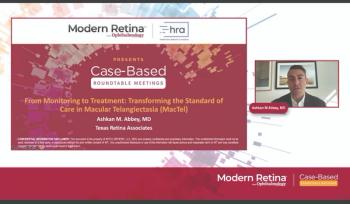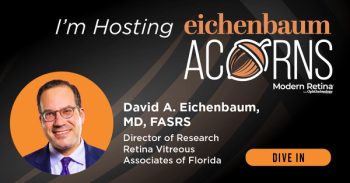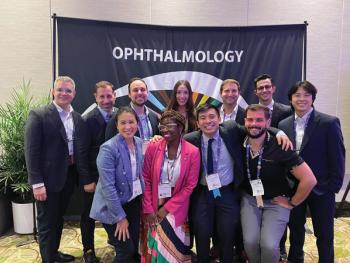
- Modern Retina July and August 2025
- Volume 5
- Issue 3
Navigating the most recent FDA approvals in retina
Catch up on recent advancements in retina care, including new therapies for age-related macular degeneration and macular telangiectasia, enhancing patient outcomes.
Now is an exciting time to be a retina specialist. A wave of innovations and regulatory approvals has emerged in the past year that has the potential to change our practice patterns. Although it can be difficult to keep up with what often seems like an endless font of presentations and publications, I would like to highlight a few recent developments that I think are particularly noteworthy.
Aflibercet-abzv: An established therapy in a new package
In August 2024, aflibercept-abzv (Enzeevu; Sandoz) was approved to treat
A notable advantage of aflibercept-abzv is that it will come in a prefilled syringe. From a workflow perspective, this should help optimize clinic efficiency, especially considering the high number of treatments many practices perform daily. From a safety perspective, using a prefilled syringe may pose a lower risk of endophthalmitis, with fewer failure points during which contamination could occur. Ultimately, it is great to have another option to integrate into our portfolio of care. Hopefully, the approval of this and other biosimilars will continue to expand access to the best possible therapies for a greater number of patients.
Photobiomodulation: A new approach for dry AMD
Another exciting development in retina has been the approval of the ValedaLight Delivery System (LumiThera) for the treatment of dry AMD.3
The approval of the Valeda Light Delivery System was based on the results of the randomized, controlled LIGHTSITE III trial (
Beyond the promising clinical trial findings, photobiomodulation is also attractive to patients, as it is a quick treatment with no needles and no pills. Although this treatment requires a somewhat onerous schedule of 9 sessions over 3 to 5 weeks, repeated 3 times a year, the individual treatments each take only approximately 5 minutes. The patients I have treated with it thus far have found it to be a simple and easy procedure that is comfortable, and they like that they can come in for treatment and then continue the rest of their day without the disruption of blurry or distorted vision.
I am excited at the prospect of having an efficacious therapy to prevent the progression of dry AMD, and I am looking forward to seeing more data about this form of therapy emerge. Although the 13-month data we have so far are encouraging, I would be interested to see the effects on a large group of patients taken out to 2 to 5 years and beyond. It will obviously take us time to accrue these data, but if the results we have seen so far hold up over time, this has the potential to be an incredibly impactful form of therapy.
Encapsulated cell therapy: The first approved therapy for macular telangiectasia type 2
Another breakthrough we have seen this year has been the approval of revakinagene taroretcel-lwey (Encelto; Neurotech Pharmaceuticals Inc) for the treatment of adults with macular telangiectasia type 2 (MacTel).8
MacTel is an uncommon condition in which the dysfunction of Müller cells, glial cells that support neurons in the retina, leads to destabilization of the outer retina and, ultimately, photoreceptor loss.9 Even when patients with MacTel have good performance on a Snellen chart, they often report significant visual disturbances, such as scotomas and metamorphopsia, and have difficulty with vision-related tasks of daily living.9,10
Historically, there has been no treatment for patients with MacTel, and management has consisted solely of monitoring for the development of subretinal neovascularization in a small subset of patients. This can cause rapid vision loss from fluid and hemorrhage, and can be treated with anti-VEGF agents.9 However, we have not had any treatment for the underlying disease.
Now we finally have an option to offer patients with MacTel. Revakinagene taroretcel-lwey is an encapsulated cell therapy, in which retinal pigment epithelial cells that have been genetically modified to produce ciliary neurotrophic factor (CNTF) are encased in a semipermeable membrane, which is then anchored to the sclera. Once implanted, the cells within the capsule can subsist on nutrients present in the vitreous. The CNTF produced by these cells can then easily reach the retina.11
The approval of revakinagene taroretcel-lwey was based on the results of 2 phase 3 clinical trials, which demonstrated a statistically significant difference in rate of change in ellipsoid zone area, a proxy measure for photoreceptor loss, through 24 months between eyes treated with revakinagene taroretcel-lwey and eyes treated with sham. Treatment with revakinagene taroretcel-lwey was also found to slow the loss of retinal sensitivity and reading speed. Revakinagene taroretcel-lwey was generally well tolerated, with the majority of treatment-emergent ocular adverse events being related to surgery.12
Of course, treatment with revakinagene taroretcel-lwey only slows progression of the disease and does not reverse vision loss. As such, there will be a bit of a learning curve to figure out which patients will most benefit from this treatment and when in the disease course intervention is most beneficial, but the approval of this truly novel therapy after decades of research represents a significant milestone for our field. This platform is also interesting and can be used to treat other retinal diseases as well.
Conclusions
The confluence of many factors has led to the highly dynamic level of change we are currently experiencing in retina, including an aging population and an increase in our patient base, improvements in imaging techniques that allow us to better understand pathophysiology, and improvements in our ability to engineer biologic therapies. These changes show no sign of abating, and I look forward to how future advances will continue to reshape how we treat and care for our patients.
Sunir Garg, MD
Garg is codirector of retina research on the Retina Service at Wills Eye Hospital, a partner with Mid Atlantic Retina, and is professor of ophthalmology at the Sidney Kimmel Medical College at Thomas Jefferson University, both in Philadelphia, Pennsylvania.
Garg reports being a consultant for the American Academy of Ophthalmology, Apellis, Bausch+Lomb, Boehringer Ingelheim, Merck Manuals, and West Pharmaceutical Services. Garg has reported performing contracted research for Adverum, Alexion, the American Academy of Ophthalmology, Annexon, Apellis, Astellas, Avonelle-X, Boehringer Ingelheim, Genentech, Gyroscope, Iveric Bio, Jefferson, KCRN, Kodiak, Lineage Cell Therapeutics, MUST Network, NGM Bio, Ocugen, OcuTerra, Opthea, Regeneron, REGENXBIO, and Roche/Genentech. Dr Garg reports having served on an advisory board for Coherus. Garg reports having received lecture fees from the Canadian Ophthalmological Society, Evolve, Physicians’ Education Resource®, and Retina Fellows Forum.
References
- Sandoz receives FDA approval for Enzeevu (aflibercept-abzv), further strengthening US biosimilar position. Press release. Sandoz. August 12, 2024. Accessed May 27, 2025. https://www.sandoz.com/sandoz-receives-fda-approval-enzeevutm-aflibercept-abzv-further-strengthening-us-biosimilar/
- Bordon AF, Kaiser PK, Wolf A, et al. Efficacy and safety of the proposed biosimilar aflibercept, SDZ-AFL, in patients with neovascular age-related macular degeneration: fifty-two-week results from the phase 3 Mylight study. Retina. 2024;44(10):1704-1713. doi:10.1097/IAE.0000000000004174
- LumiThera obtains FDA authorization of Valeda treatment for dry AMD patients to improve vision. Press release. LumiThera Inc. November 4, 2024. Accessed May 27, 2025. https://www.businesswire.com/news/home/20241104299697/en/LumiThera-Obtains-FDA-Authorization-of-Valeda-Treatment-for-Dry-AMD-Patients-to-Improve-Vision
- Fernandes AR, Zielińska A, Sanchez-Lopez E, et al. Exudative versus nonexudative age-related macular degeneration: physiopathology and treatment options. Int J Mol Sci. 2022;23(5):2592. doi:10.3390/ijms23052592
- Leng T, Schwartz J, Nimke D, et al. Dry age-related macular degeneration: distribution of visual acuity and progression risk in a large registry. Ophthalmol Ther. 2023;12(1):325-340. doi:10.1007/s40123-022-00583-y
- Evans J. Antioxidant supplements to prevent or slow down the progression of AMD: a systematic review and meta-analysis. Eye (Lond). 2008;22(6):751-760. doi:10.1038/eye.2008.100
- Boyer D, Hu A, Warrow D, et al. LIGHTSITE III: thirteen-month efficacy and safety evaluation of multiwavelength photobiomodulation in nonexudative (dry) age-related macular degeneration using the LumiThera Valeda Light Delivery System. Retina. 2024;44(3):487-497. doi:10.1097/IAE.0000000000003980
- Neurotech’s ENCELTO (revakinagene taroretcel-lwey) approved by the FDA for the treatment of macular telangiectasia type 2 (MacTel). Press release. Neurotech Pharmaceuticals Inc. March 6, 2025. Accessed May 27, 2025. https://www.neurotechpharmaceuticals.com/wp-content/uploads/Neurotech_Press-Release_BLA_Approval_FINAL.pdf
- Kedarisetti KC, Narayanan R, Stewart MW, Reddy Gurram N, Khanani AM. Macular telangiectasia type 2: a comprehensive review. Clin Ophthalmol. 2022;16:3297-3309. doi:10.2147/OPTH.S373538
- Clemons TE, Gillies MC, Chew EY, et al; Macular Telangiectasia Research Group. The National Eye Institute Visual Function Questionnaire in the Macular Telangiectasia (MacTel) Project. Invest Ophthalmol Vis Sci. 2008;49(10):4340-4346. doi:10.1167/iovs.08-1749
- Tao W. Application of encapsulated cell technology for retinal degenerative diseases. Expert Opin Biol Ther. 2006;6(7):717-726. doi:10.1517/14712598.6.7.717
- Albini TA. Phase 3, multicenter, randomized, sham-controlled studies of the efficacy and safety of revakinagene taroretcel in macular telangiectasia type 2. Presented at: Retina World Congress; May 9-12, 2024; Fort Lauderdale, FL.
Articles in this issue
Newsletter
Keep your retina practice on the forefront—subscribe for expert analysis and emerging trends in retinal disease management.












































